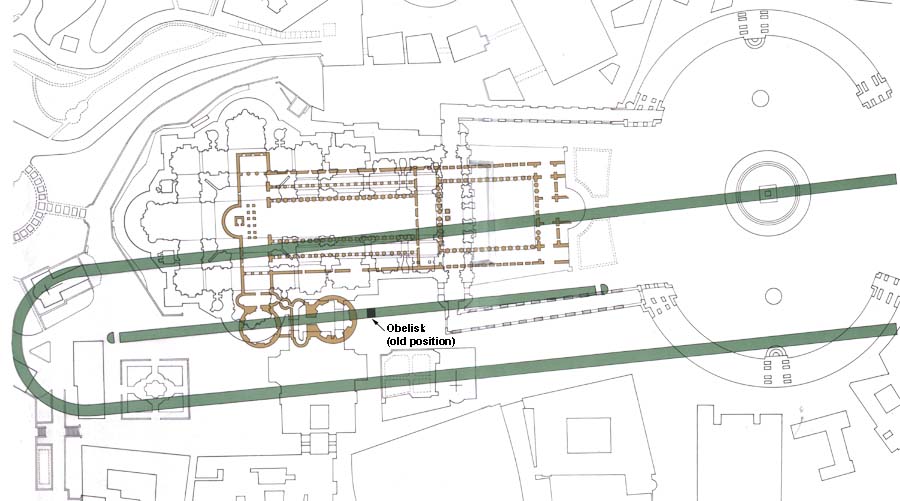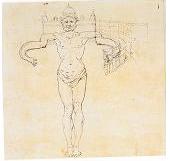|
|
 |
|
St. Peter's Piazza |
|
written
by minhan / 09.22.2005 |
|
|
| |
Introduction |
| |
| |

|
| www.italycyberguide.com |
| St. Peter |
| St. Peter Statue in Front of St. Peter's Basilica |
| |
|
| |

|
| www.stpetersbasilica.org |
| Layout of area |
| This picture shows where Nero's Circus and the Piazza lie relative to each other. |
| |
|
| |

|
| Marder, Tod A. Bernini and the Art of Architecture. New York: Abbeville Press, 1998. |
| Welcoming Arms of the Church |
| This is an interpretation of the shape of the piazza as a human figure. The two colonnades are arms open to the world. |
| |
|
The aspirations of patron Pope Alexander VII (1599-1667) and his favorite architect Gian Lorenzo Bernini (1598-1680) led to the extraordinarily magical construction of St. Peter’s Piazza. Also known as Piazza San Pietro, the area before St. Peter’s basilica was redesigned to its full glamour during the period of 1656 to 1667 by Bernini as part of the pilgrimage approach to the basilica. It stands today in the smallest country in the world, the Vatican City. The shape of the piazza was purposefully designed to symbolize St. Peter’s basilica, “the mother church of Christianity” and its embracing welcome to the world.
The piazza was named in honor of St. Peter. St. Peter, the Prince of the Apostles and the first pope played a major role in Christianity. In the Bible, Jesus said to Peter, “You are ‘Rock’, and on this rock I will build my Church, and the jaws of death shall not prevail against it” (Mt 16:19). Jesus was entrusting Peter to be the foundation stone of his Church.
St. Peter’s Basilica originated from the Martyrdom of Peter in 64 AD. There was a huge fire that destroyed the greater part of Rome. Emperor Nero held Christians responsible and ordered many of them to be executed. Peter was sentenced to crucifixion in Nero’s Circus, which was at the foot of the Vatican hill. He was crucified upside down because he did not feel he was worthy enough to be crucified upright like Jesus Christ. He was buried in a burial ground near the Circus, where pagans had also been buried. In 319 AD, Emperor Constantine the first Christian Emperor, at the request of Pope St. Sylvester I, built St. Peter’s Basilica above St. Peter’s Tomb by filling the Vatican Necropolis and part of the Circus. This original basilica was half the size of the modern one. The original basilica suffered much looting throughout the years during barbarian invasions and in the 15th century, the old basilica showed signs of collapse. Many patrons tried to repair the basilica but nothing was completed until 1506 when Pope Julius II decided to rebuild with the help of Bramante, Raphael, and Michelangelo. In 1605, Paul V rebuilt the façade, assigning Carlo Maderno as the chief architect.
Bernini’s talent was recognized by many nobles and patrons such as Pope Urban VIII, Cardinal Francesco Barberini, and Pope Alexander VII. As a result, when the decision was made to redesign the piazza on July 31, 1656, he was given the appointment as the architect of St. Peter’s by Pope Alexander VII. Peter’s major role in the Catholic Church is one of the main reasons why Pope Alexander VII felt it was necessary to redesign the open area before St. Peter’s basilica. The approach needed to fully represent the greatness of St. Peter’s and authority of the Catholic Church. Bernini’s main objective was to fully interpret the great meaning of the basilica and provide a sacred area where the faithful could come and be protected from the harsh outside world. Logistically and spiritually, the area required precise and creative planning. Bernini had to work around previously built structures and build both an opening that had a grand welcoming approach and an area which allowed “the greatest number of people to see the Pope give his blessing….” According to Bernini himself, his Baroque Neoclassical architectural design of the piazza allowed the faithful visitors to be embraced by “the motherly arms of the church.”
|
| |
|
| |
|
|
 |
|


